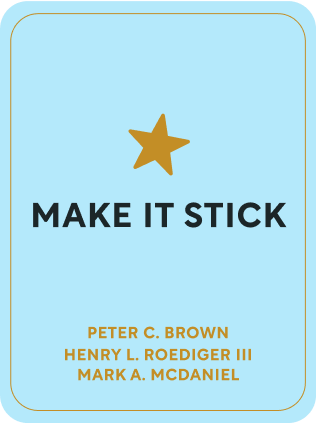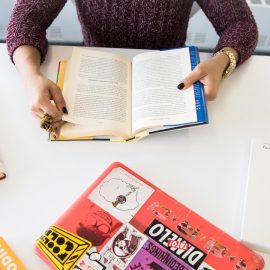

This article is an excerpt from the Shortform book guide to "Make It Stick" by Peter C. Brown, Henry L. Roediger III, Mark A. McDaniel. Shortform has the world's best summaries and analyses of books you should be reading.
Like this article? Sign up for a free trial here .
Are you looking for Make It Stick quotes? What are some of the most noteworthy passages worth revisiting?
In their book Make It Stick, Henry L. Roediger III, Mark A. McDaniel, and Peter C. Brown teach you how to learn and study based on data about how your brain comprehends and retains information. The book’s principles and prescriptions draw from a vast number of research studies. This book doesn’t help you simply pass the midterm—it teaches you how to absorb and master new information.
The following Make it Stick quotes highlight some of the key points.
Make It Stick: The Science of Successful Learning
Although people spend their entire lives learning, most of them are doing it wrong. Strategies like rereading and drilling a skill over and over to commit it to memory take a lot of time and ultimately don’t work.
Make It Stick teaches you the strategies that help you achieve the two primary goals of learning: To understand and remember what you learn so you can use your knowledge in future situations.
Below is a selection of Make It Stick quotes by Peter C. Brown.
“Practice that’s spaced out, interleaved with other learning, and varied produces better mastery, longer retention, and more versatility. But these benefits come at a price: when practice is spaced, interleaved, and varied, it requires more effort. You feel the increased effort, but not the benefits the effort produces. Learning feels slower from this kind of practice, and you don’t get the rapid improvements and affirmations you’re accustomed to seeing from massed practice.”
Spaced practice is a study technique that involves multiple short study sessions spaced out over time. Spaced practice may feel less productive than cramming initially because you’ve forgotten some of the material and it feels like you don’t have a grasp of it—but that extra effort is precisely what makes the method effective. There are two methods that improve comprehension and retention while organically spacing your practice:
Interleaved practice: mixing up your practice among multiple related topics or skills. Interleaved practice improves your comprehension and retention in two ways:
- Switching among different topics naturally spaces out your practice in any one area.
- Changing your focus among related topics helps you make connections among them, which deepens your understanding of each subject.
Varied practice: practicing a skill in different contexts, which strengthens your ability to apply that skill to a variety of situations. Varied practice strengthens your understanding of the underlying principles and makes you better at discerning among different contexts to determine the best way to approach a situation.
Interleaved and varied practice strengthen your conceptual knowledge of the underlying principles, as opposed to a simple surface-level understanding of facts and figures. The conceptual knowledge you gain through these methods improves your ability to discriminate, or determine what knowledge or which skill you need in various situations. This is a crucial aspect of using what you learn in real-life situations.
“Retrieval practice—recalling facts or concepts or events from memory—is a more effective learning strategy than review by rereading. Flashcards are a simple example. Retrieval strengthens the memory and interrupts forgetting. A single, simple quiz after reading a text or hearing a lecture produces better learning and remembering than rereading the text or reviewing lecture notes.”
According to the authors, the most effective way to improve learning retention is through retrieval practice. Retrieval is any exercise that requires you to recall the information or skill you’ve learned.
Think of learning like stringing beads for a necklace: Every new fact, concept, and skill is a bead, and your memory is the string. The beads will simply slide off the other end of the string if you don’t tie a knot to keep them in place. Retrieval is the knot at the end of the string that prevents you from forgetting what you learn. When you repeatedly practice retrieval, you’re double- and triple-knotting the string to make sure the beads don’t slip off.
The better you remember something, the more reflexively you can recall that information when you need it, which is a key aspect of mastery. For example, a quarterback practices movements and scenarios until they become second nature—because when it’s game time, he won’t have a spare second to stop and think about what he has to do.
“Rereading has three strikes against it. It is time-consuming. It doesn’t result in durable memory. And it often involves a kind of unwitting self-deception, as growing familiarity with the text comes to feel like mastery of the content. The hours immersed in rereading can seem like due diligence, but the amount of study time is no measure of mastery.”
Most people believe that rereading and massed practice (practicing one thing over and over in one sitting) are the most effective ways to learn and remember information. However, single-subject focus and endless repetition present three problems:
1) They take a lot of time. The time you spend rereading would be better spent using other, more effective strategies, which we’ll get into later.
2) They don’t help you remember the information long term. You may remember the material long enough to pass a test the following day, but you’ll forget most of it by the time the midterm rolls around. In fact, research proves that retention quickly fades with these methods.
3) They fool you into thinking you’ve mastered the material. Rereading in succession makes you more familiar with the specific text and its wording, which tricks you into thinking you’ve mastered the concepts behind the text. Mastery requires you to know the information, grasp the underlying ideas and concepts, and understand how to apply them to different situations.
“The stories we create to understand ourselves become the narratives of our lives, explaining the accidents and choices that have brought us where we are: what I’m good at, what I care about most, and where I’m headed.”
Here, the authors discuss how narratives (both external and internal) influence the way we remember and interpret our experiences. This lends itself to memory distortions:
- Flashbulb Memories: You tend to believe that there’s no way you’d forget or mistake any detail of major, emotional events because you have a “flashbulb memory” of the experience—you recall where you were, what you did, and how you felt. However, research shows that although people tend to have the highest confidence in their most emotional memories, these are the memories that become altered the most over time.
- Hindsight Bias, or the Knew-It-All-Along Effect: When you’re reflecting on an event, you’re likely to inflate how predictable it was, even though you couldn’t have actually predicted it before it happened.
- Interference: If you’re exposed to something right before or after an experience, it can distort the memory of that experience. For example, if a witness to a crime views photos of suspects and then subsequently looks at a lineup, she’s more likely to falsely accuse someone in the lineup if she’s already seen his photo.
- Mistaking Implications for Fact: As you naturally fill in the details of your memory, you’re likely to remember things that you understood to be implied and assumed to be fact, but which may not be. For example, when you recall a meeting with your boss about your new promotion, you probably assumed that a pay raise was implied, and thus you may falsely remember your boss stating that you’d receive a raise with your new title, but that’s not the case.
- Power of Suggestion: Other people’s suggestions can heavily influence and alter your memories. For example, study participants watched a video of a car running a stop sign and hitting another car. Those who were asked how fast the car was going when it “smashed” into the second car guessed 41 miles per hour, while those who were asked how fast the car was going when it “contacted” the second car guessed 32 miles per hour. By simply changing the language of the question, researchers changed participants’ memories of the video.
- Social Contagion of Memory, or Memory Conformity: If you and a friend are recalling a joint experience, you’re likely to merge her memories with your own—even if she supposedly remembers something that didn’t actually happen. In other words, other people’s errors can contaminate your memory.

———End of Preview———
Like what you just read? Read the rest of the world's best book summary and analysis of Peter C. Brown, Henry L. Roediger III, Mark A. McDaniel's "Make It Stick" at Shortform .
Here's what you'll find in our full Make It Stick summary :
- How to understand and remember what you learn
- How a little forgetting helps you remember
- Why you’re not a good judge of how much you know






